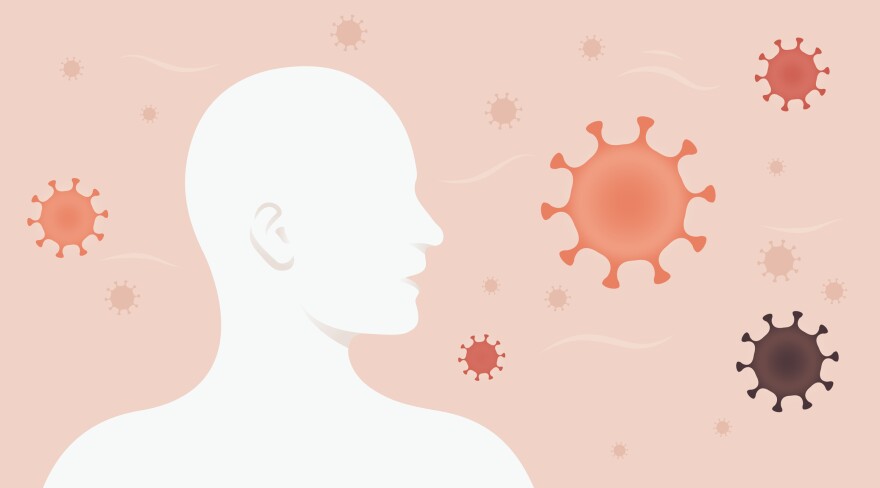Heading into the holidays, listeners and readers have sent several questions about the coronavirus — the new strain, boosters, long-term symptoms and more. StateImpact conducted interviews and attended briefings on the subject.
The following answers are from Dr. Dale Bratzler, who is the chief COVID officer at OU Health and Dr. David Kendrick, the department chair of Medical Informatics at OU School of Community Medicine.
Q: With the first strain of the coronavirus, the tell-tale symptoms were the loss of taste and smell. That didn’t happen as much with the Delta variant. What are the first signs of the Omicron variant?
Bratzler: The initial presenting symptoms of Omicron tend to be mild or very cold-like So if you start having a sore throat, runny nose, sneezing — headache is a prominent symptom. If you have those symptoms, consider getting a test, or certainly don't go to work. If you're sick, don't go to holiday parties and things like that. If you're having any of those symptoms. Omicron may present with less severe symptoms that mimic the common cold. So that thing that you think may be the common cold could be COVID-19.
Q: With the first round of vaccines, full immunity didn’t hit until two weeks after the second dose. How long does immunity take after the booster?
Bratzler: That actually seems to be pretty quick. You know, officially, the CDC probably will tell you two weeks. But we typically see antibody levels in the studies that have been published start growing up fairly quickly, certainly within a week or so. So I think getting a booster dose can give you some fairly good and quick protection because you've already got the basic immunization done.
Q: Are Oklahomans typically getting their boosters?
Bratzler: Only about a quarter of the eligible people have actually sought out and gotten their booster shot. In our conversations here at the university, we started asking, “Why? Why are people not pursuing their booster shots?” And I think one of the things that came up in our conversation was that a lot of people, when they got the initial two doses of the vaccine, had quite a few side effects with the second dose. They remember that. And that's discouraged some of them from getting it. It turns out that the side effects from a booster dose don't appear to be as great — and certainly no worse than — the second dose of the vaccine.
Q: How long does it take for immunity from the first two doses to start waning?
Bratzler: The antibody levels seem to start falling somewhere about four months after you get your initial priming series of the two RNA vaccines, and they can drop fairly substantially. And there are numerous studies that have shown this. So you may have some protection against hospitalization and death. Remember there's another immune system (protecting you) — your immune memory, the T system — that we don't have good ways to measure right now. So it doesn't mean you're not protected, but your antibody levels do fall off.
Q: There is an argument that natural immunity from a prior COVID-19 infection is as protective as the vaccine. Is that true?
Bratzler: That actually isn't the case. One study that looked at neutralizing antibodies showed that they fell off fairly rapidly after you recover from infection. A study that was done by the CDC — 201,000 patients in 187 hospitals. They compared patients who were fully vaccinated with an RNA vaccine to patients who had COVID and recovered. And they showed that people who had recovered from COVID-19 but not but were not vaccinated were 5.5 times more likely to be reinfected with COVID-19 than people who got the vaccine.
Q: The COVID case counts don’t seem to be very high. Does that mean there isn’t cause for concern yet?
Kendrick: I think that has a lot to do with the fact that home testing kits are being used, and that there are a lot of probably asymptomatic positives out there that are not getting tested at all. People that are getting tested at home, those don't report into the medical system, so we don't see them either. Neither public health nor the medical system sees those results. And so I think we've got to assume that there's a larger, smoldering pool of COVID-19 in the population than is actually getting into the system.
Are our hospitals starting to see strain because of COVID-19?
Bratzler: Oklahoma just hasn't seen the big surge that the nNortheast has seen yet. We've seen it before. It starts in the northeast, on the coast and rolls it's way down in the mMidwest, to Oklahoma. and I don't think we've seen the worst of this yet. And so while we may not need a whole lot of additional support right at this moment with ambulance crews and other things, we may in two weeks. So I think we're all holding our breath to see what happens.
If you have a question that wasn’t answered, send an email to catherine@stateimpactoklahoma.org.





